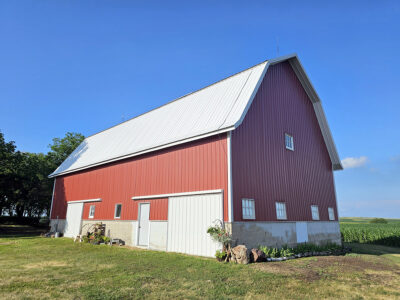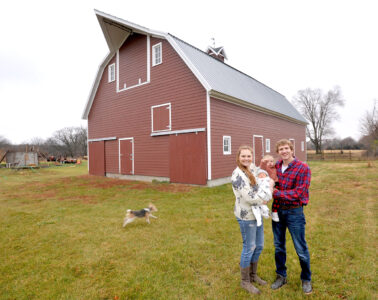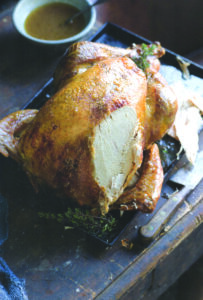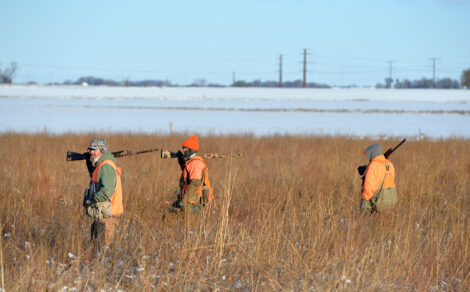Highlighting Iowa’s legacy
Fall All-State Barn Tour features 103 stops; Free self-guided tour runs Sept. 13-14
-
-Photo by Virginia Underwood
The Hanke Legacy Farm Barn near Mitchellville in Jasper County has stood strong since it was built in 1920. It is one of a record 103 barns being featured on the Iowa Barn Foundation’s 2025 fall All-State Barn Tour Sept. 13-14.
-
-Photo by Virginia Underwood
The Hanke Legacy Farm Barn near Mitchellville in Jasper County suffered significant damage when a derecho rolled through the area in August 2020. Since then, the barn has been repaired and restored, and in 2024, the Hanke family received the Iowa Barn Foundation’s Barn of Distinction Award.
- The Souder Barn is located near Lytton.
-
-Messenger file photo
Libby and Matt Mitchell, along with Everly and Eli, pose with their restored barn southeast of Evanston in this 2022 photo.
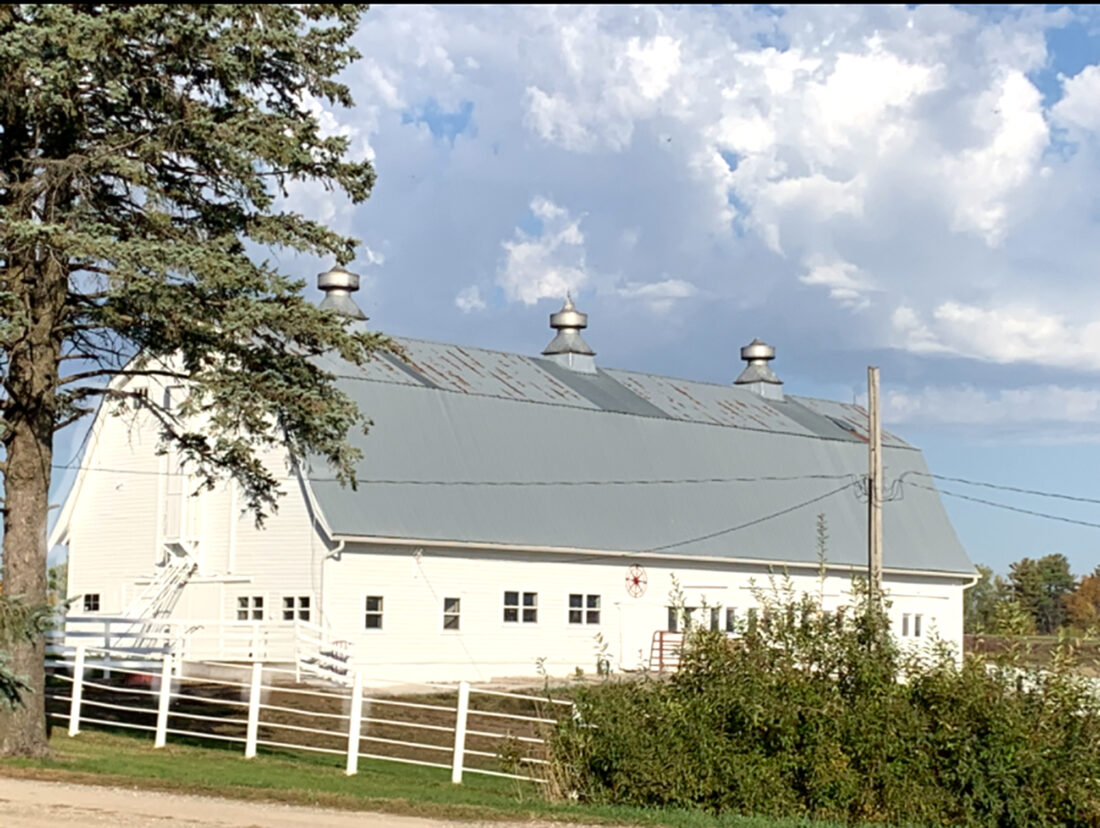
-Photo by Virginia Underwood
The Hanke Legacy Farm Barn near Mitchellville in Jasper County has stood strong since it was built in 1920. It is one of a record 103 barns being featured on the Iowa Barn Foundation's 2025 fall All-State Barn Tour Sept. 13-14.
The 2025 fall All-State Barn Tour runs Sept. 13-14, and featured on that tour will be an iconic dairy barn — easily seen from Interstate 80 — that has weathered a derecho, market crashes and more.
The All-State Tour highlights barns that have received restoration grants from the Iowa Barn Foundation and those that have received an Award of Distinction or Preservation Award for restoration that’s been fully funded by the owner.
The Hanke Legacy Farm Barn near Mitchellville in Jasper County has stood strong since it was built in 1920. The barn’s design came from the Louden Machinery Company with detailed plans chosen by the family from a catalog.
The construction cost of the barn was just $3,000, noted Virginia “Ginny” Underwood, whose grandfather was the third owner of the barn and farm.
The barn measures 110-by-36-by-38 feet and originally kept a team of Percheron draft horses and mules safe from the elements when they weren’t pulling plows and other equipment typical of that time. The land and buildings changed hands due to the ag economy’s struggles, and eventually landed with Alvah Hanke, who started a milking operation.
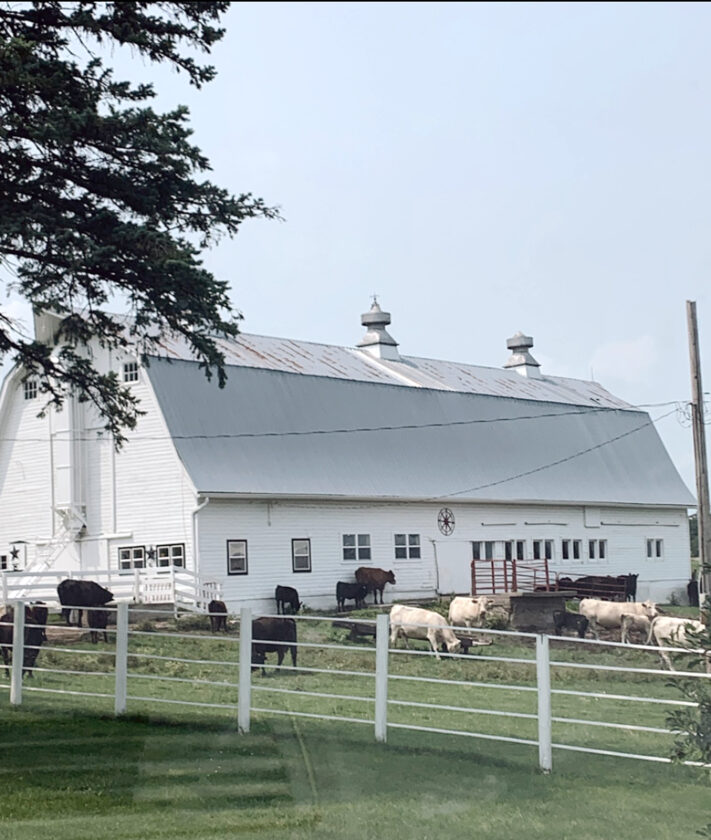
-Photo by Virginia Underwood
The Hanke Legacy Farm Barn near Mitchellville in Jasper County suffered significant damage when a derecho rolled through the area in August 2020. Since then, the barn has been repaired and restored, and in 2024, the Hanke family received the Iowa Barn Foundation’s Barn of Distinction Award.
“It’s just a monument to days gone by,” Underwood said.
Hanke milked dairy cows by hand and took the milk to his nephew’s Dairyland business in Des Moines. When Underwood’s dad, Ken, returned from World War II where he served as an Army Air Forces pilot, he moved into the old farmhouse at the homestead with his wife, Ellie, and their oldest daughter, Virginia.
“He expanded the dairy operation to 17 cows and implemented a Surge bucket milking system. He also restructured the barn by pouring concrete for more stanchions and added mangers, gutters, alleyways and holding pens,” Underwood said. “He also installed a Farmtec 167 elevator and conveyor. The permanent elevator goes straight up the front of the barn, carrying square bales to the conveyor in the mow with sockets for bars to drop bales at specific places down the 110-foot-long hay mow.”
The gambrel roof design with no horizontal rafters allows for the storage of 20,000 square bales of hay and straw. Underwood’s dad also farmed corn, oats and soybeans, plus raised hogs, chickens, registered Angus cattle and even chinchillas for a brief period of time. But the registered Holsteins carried the brunt of the family farm business, which became a Grade A dairy operation.
Ken and Ellie Hanke also welcomed three more children to the family.

The Souder Barn is located near Lytton.
Underwood described a day on the farm as “grueling.” Milking started at 5 a.m. with a second shift at 5 p.m. Equipment was sanitized, the barn cleaned out and the cows were given fresh bedding daily. Then, of course, all the other animals needed tending to, as well. In the 1960s, the dairy operation brought on a Chore Boy Pit milking system, which allowed them to expand the dairy herd to more than 50 cows.
“Although this was more time efficient and financially beneficial, our father said he missed the connection with each animal with the transition to milking automation,” Underwood said. “The barn was the place to tame, train, wash and groom many 4-H calves and cows, giving rise to a few county and state-fair champions along the way. All four children were fortunate to be involved in 4-H clubs supported by their parents, who also found the time to volunteer as leaders.”
Underwood and her husband, Bob, moved into the small house on the family farm in the late 1960s. They attended registered Holstein sales, bought heifers and cows, and fully immersed themselves in the family dairy business, inseminating their herds themselves for such characteristics as milk production, form and longevity genetic traits.
But eventually, the Hanke dairy herd was sold in September 1975. The operation transitioned from Limousin cattle to Angus beef cattle, with the help of a young local farmer in the late 1970s who continues to care for the herd and plant and harvest crops.
“Still standing tall at 100 years old, our old barn took a significant beating from the derecho storm that rolled through Iowa in August 2020. The north end of the barn was pushed east off its foundation, buckling and bowing the beautiful 100-year-old boards, leaving the barn precariously leaning to the east,” Underwood said. “The insurance adjuster would not even approach the back of the barn. He was afraid it would fall in on him.”
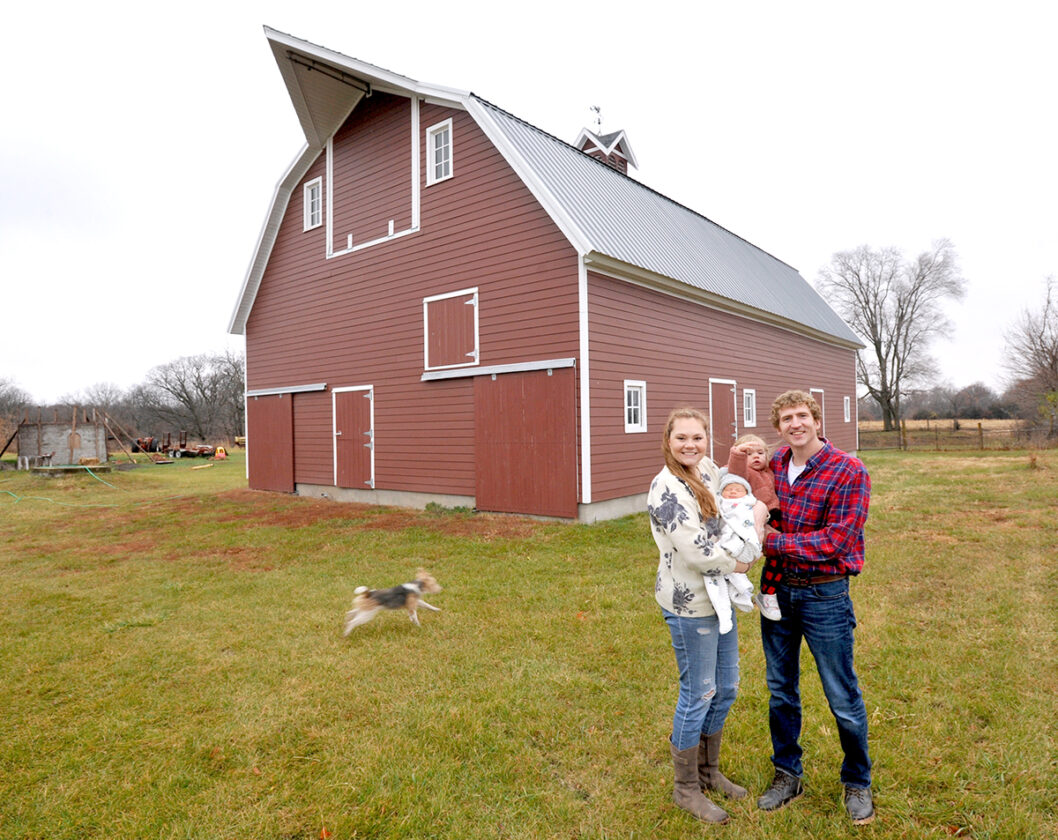
-Messenger file photo
Libby and Matt Mitchell, along with Everly and Eli, pose with their restored barn southeast of Evanston in this 2022 photo.
After getting nowhere with construction businesses they contacted for help in fixing the barn, the Underwoods heard back from Big Timber Barn Company, now JB Timber Concepts, who not only offered to help, but knew exactly where the barn was located.
“He said, ‘I know exactly the barn you’re talking about. We see it often on our drives down I-80,'” Underwood said. “I think the bales of hay and straw actually stabilized the barn over the years. But we knew that if we didn’t repair it, it would fall down.”
The crew came, checked out the barn and started to straighten it out and repair the damage without a promise that their efforts would be successful.
Underwood affixed a giant “Believe” sign on the front of the barn and, sure enough, the historical structure slowly moved back into place.
“We were so excited. The interior was braced with support beams, damaged wood was replaced with new wood panels and new windows were installed where the frames had buckled under the storm’s pressure,” Underwood said. “Then she received a fresh coat of paint.”
In 2024, the Hanke family received the Iowa Barn Foundation’s Barn of Distinction Award.
“Today, our barn stands tall and strong, a true monument to Iowa’s rich agricultural heritage. It is a reminder of the unwavering spirit and endurance of those who came before, a symbol of perseverance and the enduring power of family and farmers,” Underwood said. “We saved our barn not just for our family, but also out of gratitude, and in memory of our parents and grandparents, for the generations to come.”
If You Go
The 2025 self-guided fall All-State Barn Tour is free and open to the public. Barns will be open for touring from 9 a.m. to 5 p.m. Sept. 13-14. To view the entire list of barns on the tour, visit the Iowa Barn Foundation’s website at iowabarnfoundation.org
Local Barns on the Tour
Calhoun County
Clancy Barn
1866 Marengo Avenue, Pomeroy
At the intersection of Iowa Highway 4 and Iowa Highway 7, this barn was built in 1948 by Lee and Maureen Olson, along with local carpenter George Julifs. Maureen and Lee put pieces of the barn together in the machine shed prior to erection of the building. In 1962, the farm was purchased by Leo and Geraldine Clancy of Pomeroy. (Restoration Grant)
Ellis Barn
2370 Fletcher Avenue, Lytton
This barn is three miles east and 2.5 miles north of Lytton. The landmark red barn, used to raise Red Rock Arabians, is called the “big red barn” by locals. It was built in 1918 and is 40 feet high to the eaves. It has 3-by-12-inch timbers. (Restoration Grant)
Souder Farms Barn and Corn Crib
2284 Elkland Ave., Lytton
Six-tenths of a mile north of U.S. Highway 20 on Elkland Avenue, this barn was built in 1925 by Oscar Nordine, a local carpenter who constructed many farm buildings in the area. The 40-by-58-foot barn was originally built to house dairy cattle and horses. The Souders purchased the farmstead in 2019, and the barn has been cleaned up to use for family gatherings. (Preservation Award)
Palo Alto County
Wigdahl Barn, 4030 360th Ave., Ruthven
From Ruthven, go one mile east on U.S. Highway 18 (360th Street), then turn right (south) onto 360th Avenue, and go 4.25 miles. The barn was built in 1936 and stands at 34-by-64-feet with red clay tile along the bottom. (Restoration Grant)
Pocahontas County
Ferguson Barn, 40415 130th Ave., Laurens
This barn is 3.75 miles north of Laurens at 40415 130th Ave. The barn and landmark “conehead” crib were built in 1912, constructed from hollow clay tile. Barn continues to be used for horses. The elevator still works in the corn crib. (Restoration Grant).
Webster County
Mitchell Barn, 2723 255th St., Duncombe
In December of 2019, Vote House Moving, of Bradgate, took on the challenge of moving this 1915 barn across fields to Matthew Mitchell’s acreage in Webster County. (Restoration Grant)



